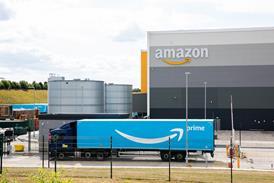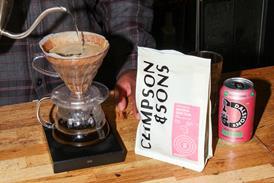Suppliers could release vital money for development if only they would admit they’ve lost control of trade funds and then DO something about it, says Siân Harrington
Hands up if the following words from a sales director at a £400m supplier sound familiar: “We had our biggest volume week ever, the champagne corks were popping and we were all celebrating. Then we realised we had lost money.”
If you are a supplier then your hands should probably be in the air now. If they are not, you are either one of the few who truly understands how to get the most from your annual investment in your retail customers or, more likely, you don’t even know if you lost money in the first place.
This is because, whether you admit it or not, you don’t have the foggiest idea how effective your investment in your individual customers is - despite it being the second largest dent in your P&L each year. In fact, as much as 40-50% of a consumer goods company’s P&L is commercial expenditure according to Commercial Advantage Consulting, which helps such companies develop brands, transform relationships and prepare for the future.
A senior executive at one global brand manufacturer admits: “It is frightening how we fail to control trade expenditure. We need more control and more visibility.”
Well, wake up because the time for being an ostrich is over. How can you expect to drive your business forward if you do not understand what’s happening to your second biggest investment each year - a figure that’s likely to run into many thousands, it not millions of pounds?
Suppliers commonly complain that the increasing demands from retailers,coupled with the deflationary pressures of today’s market, limits their ability to invest in their brands and in new product development. And this will fundamentally damage the quality of offering to the consumer.
So getting a grip of trade spend is not just desirable, it is vital if such manufacturers are to build value back into their businesses by releasing monies for investment elsewhere.
Commercial Advantage Consulting managing director Aidan Bocci is adamant: “This is the biggest must-fix for any company. It just has to change because so much money in involved.”
The situation is all the more pressing as investment is no longer confined to issues related to trade terms, such as volume discounts, logistical efficiency discounts and listings fees; nor restricted to promotions like temporary price reductions, gondola end display fees or shipper units. It’s now also about above-the-line spend: car park ads, instore digital media, store magazines, lorry advertising… the list goes on.
But as any supplier knows, taking this money off the table is not an option. Getting more for your money is - both for supplier and retailer. The goal is to understand the net P&L by customer. You will not only help retailers grow the category but you can rejig your spend so that it is concentrated on the activities that make most profit for you. The result? Increased turnover, extra profit and more to invest in brand support - all with no change to your initial trade spend.
It sounds simple. So why aren’t suppliers doing this already? The problem is that trade monies are found in different budgets - in marketing, sales, customer marketing, logistics, even in cheques written by chief executives. In fact, Commercial Advantage Consulting has identified 55 ways to spend and misspend trade money. Each department can manage it differently- and so can each department employee.
For example, the average sales function has 20 people, each managing his own promotion, typically using Excel spreadsheets. Bocci says: “Brands routinely spend £5m on advertising and put aside 5% for econometric modelling, which is conducted by real experts.
“Yet a supplier may spend £1.5m on a trade promotion often without any quality measurement at all - the processes, skills or time are not available.”
Managing such complexity improves with technology, so trade fund management solutions are beginning to be seen as the next big thing (see Supply IT supplement, free with this issue of The Grocer).
Some manufacturers are already adopting the technology. Heinz, for example, is working with solutions provider MEI to plan, manage and analyse trade funds expenditure. “We are re-engineering our processes in the management of trades funds in Europe. The MEI solution will help us provide a consistent corporate approach as well as drive improved account and promotion planning,” says European IS development manager Richard Knee.
German solutions provider CAS has entered the UK and is in advanced talks with a global brand owner. Another major international player already has a system in place which, it says, is putting visibility at new levels, driving new behaviour and making the finance department very happy.
Bocci says that awareness of the problem is growing, but not necessarily of the solutions. “If they really knew what could be done they would be doing it already.” He believes the barriers to action are largely cultural and that it will take another three to five years for things to really change. “Many suppliers are embarrassed by the fact that they don’t fully appreciate how much they are spending. But those who do not confront it are just creating a bigger problem for themselves in the future,” he says.
And, as Adrian Goodliffe, managing director of MEI UK, says: “Once they have admitted the problem they have to get a budget to deal with it. Brands are just not used to setting aside this sort of budget in the sales area.” He points to one company in which a trade funds management solution is number one on the sales director’s wishlist but a year later he still cannot get sign off. The budget required for such a solution is likely to range from £300,000 to £1m.
This issue must be confronted and it is likely solutions offered by the latest technologies will be put into the sales function in the same way they are within financial departments. “If there is a good sales director he will drive this. If not, it could be the finance director looking for answers to a £50m black hole,” says Goodliffe.
But Bocci believes investment behind customer profitability analysis could spring a few surprises. “Everyone thinks they’re spending too much. They may actually be spending the right amount. The problem is they are not spending it well.”
Hands up if the following words from a sales director at a £400m supplier sound familiar: “We had our biggest volume week ever, the champagne corks were popping and we were all celebrating. Then we realised we had lost money.”
If you are a supplier then your hands should probably be in the air now. If they are not, you are either one of the few who truly understands how to get the most from your annual investment in your retail customers or, more likely, you don’t even know if you lost money in the first place.
This is because, whether you admit it or not, you don’t have the foggiest idea how effective your investment in your individual customers is - despite it being the second largest dent in your P&L each year. In fact, as much as 40-50% of a consumer goods company’s P&L is commercial expenditure according to Commercial Advantage Consulting, which helps such companies develop brands, transform relationships and prepare for the future.
A senior executive at one global brand manufacturer admits: “It is frightening how we fail to control trade expenditure. We need more control and more visibility.”
Well, wake up because the time for being an ostrich is over. How can you expect to drive your business forward if you do not understand what’s happening to your second biggest investment each year - a figure that’s likely to run into many thousands, it not millions of pounds?
Suppliers commonly complain that the increasing demands from retailers,coupled with the deflationary pressures of today’s market, limits their ability to invest in their brands and in new product development. And this will fundamentally damage the quality of offering to the consumer.
So getting a grip of trade spend is not just desirable, it is vital if such manufacturers are to build value back into their businesses by releasing monies for investment elsewhere.
Commercial Advantage Consulting managing director Aidan Bocci is adamant: “This is the biggest must-fix for any company. It just has to change because so much money in involved.”
The situation is all the more pressing as investment is no longer confined to issues related to trade terms, such as volume discounts, logistical efficiency discounts and listings fees; nor restricted to promotions like temporary price reductions, gondola end display fees or shipper units. It’s now also about above-the-line spend: car park ads, instore digital media, store magazines, lorry advertising… the list goes on.
But as any supplier knows, taking this money off the table is not an option. Getting more for your money is - both for supplier and retailer. The goal is to understand the net P&L by customer. You will not only help retailers grow the category but you can rejig your spend so that it is concentrated on the activities that make most profit for you. The result? Increased turnover, extra profit and more to invest in brand support - all with no change to your initial trade spend.
It sounds simple. So why aren’t suppliers doing this already? The problem is that trade monies are found in different budgets - in marketing, sales, customer marketing, logistics, even in cheques written by chief executives. In fact, Commercial Advantage Consulting has identified 55 ways to spend and misspend trade money. Each department can manage it differently- and so can each department employee.
For example, the average sales function has 20 people, each managing his own promotion, typically using Excel spreadsheets. Bocci says: “Brands routinely spend £5m on advertising and put aside 5% for econometric modelling, which is conducted by real experts.
“Yet a supplier may spend £1.5m on a trade promotion often without any quality measurement at all - the processes, skills or time are not available.”
Managing such complexity improves with technology, so trade fund management solutions are beginning to be seen as the next big thing (see Supply IT supplement, free with this issue of The Grocer).
Some manufacturers are already adopting the technology. Heinz, for example, is working with solutions provider MEI to plan, manage and analyse trade funds expenditure. “We are re-engineering our processes in the management of trades funds in Europe. The MEI solution will help us provide a consistent corporate approach as well as drive improved account and promotion planning,” says European IS development manager Richard Knee.
German solutions provider CAS has entered the UK and is in advanced talks with a global brand owner. Another major international player already has a system in place which, it says, is putting visibility at new levels, driving new behaviour and making the finance department very happy.
Bocci says that awareness of the problem is growing, but not necessarily of the solutions. “If they really knew what could be done they would be doing it already.” He believes the barriers to action are largely cultural and that it will take another three to five years for things to really change. “Many suppliers are embarrassed by the fact that they don’t fully appreciate how much they are spending. But those who do not confront it are just creating a bigger problem for themselves in the future,” he says.
And, as Adrian Goodliffe, managing director of MEI UK, says: “Once they have admitted the problem they have to get a budget to deal with it. Brands are just not used to setting aside this sort of budget in the sales area.” He points to one company in which a trade funds management solution is number one on the sales director’s wishlist but a year later he still cannot get sign off. The budget required for such a solution is likely to range from £300,000 to £1m.
This issue must be confronted and it is likely solutions offered by the latest technologies will be put into the sales function in the same way they are within financial departments. “If there is a good sales director he will drive this. If not, it could be the finance director looking for answers to a £50m black hole,” says Goodliffe.
But Bocci believes investment behind customer profitability analysis could spring a few surprises. “Everyone thinks they’re spending too much. They may actually be spending the right amount. The problem is they are not spending it well.”













No comments yet